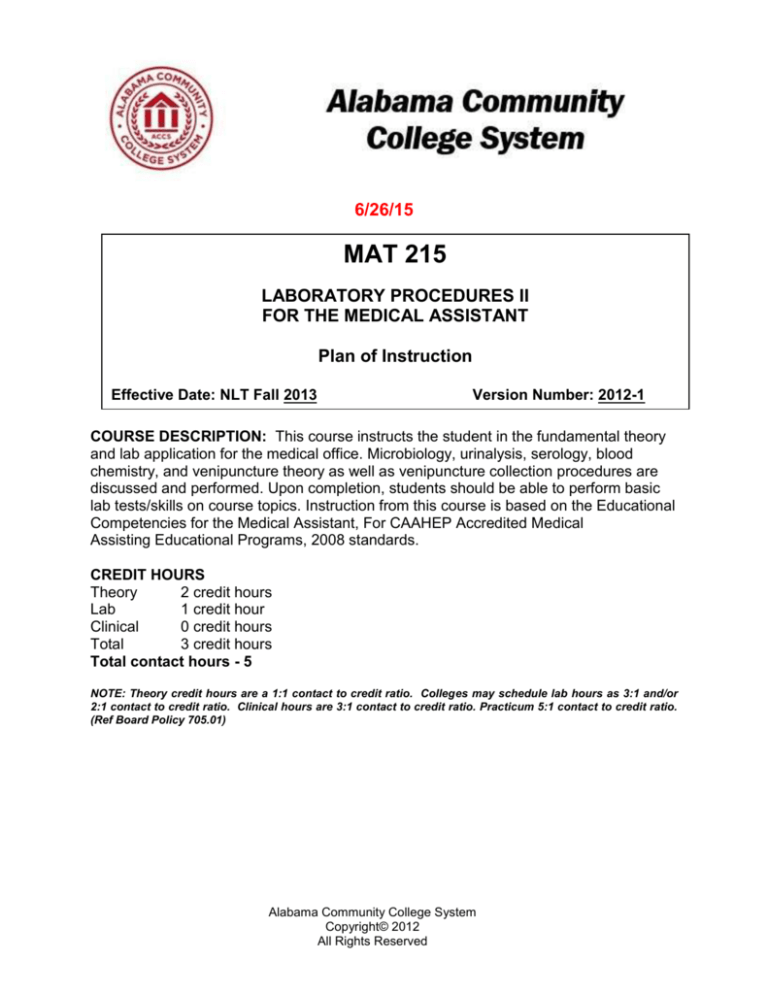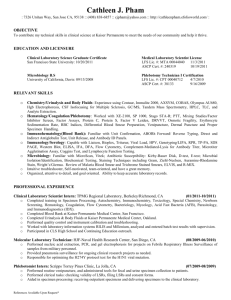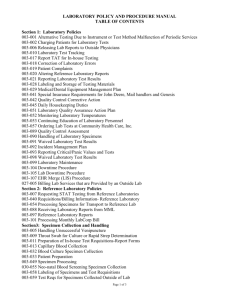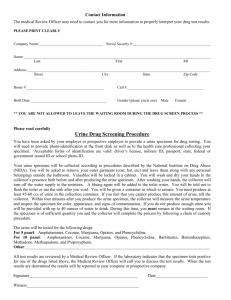
6/26/15
MAT 215
LABORATORY PROCEDURES II
FOR THE MEDICAL ASSISTANT
Plan of Instruction
Effective Date: NLT Fall 2013
Version Number: 2012-1
COURSE DESCRIPTION: This course instructs the student in the fundamental theory
and lab application for the medical office. Microbiology, urinalysis, serology, blood
chemistry, and venipuncture theory as well as venipuncture collection procedures are
discussed and performed. Upon completion, students should be able to perform basic
lab tests/skills on course topics. Instruction from this course is based on the Educational
Competencies for the Medical Assistant, For CAAHEP Accredited Medical
Assisting Educational Programs, 2008 standards.
CREDIT HOURS
Theory
2 credit hours
Lab
1 credit hour
Clinical
0 credit hours
Total
3 credit hours
Total contact hours - 5
NOTE: Theory credit hours are a 1:1 contact to credit ratio. Colleges may schedule lab hours as 3:1 and/or
2:1 contact to credit ratio. Clinical hours are 3:1 contact to credit ratio. Practicum 5:1 contact to credit ratio.
(Ref Board Policy 705.01)
Alabama Community College System
Copyright© 2012
All Rights Reserved
Laboratory Procedures II For The Medical Assistant
Mat 215
PREREQUISITE COURSES
None
CO-REQUISITE COURSES
None
INSTRUCTIONAL GOALS
Cognitive - Comprehend foundational knowledge of specified laboratory
procedures.
Psychomotor - Apply concepts related to specified laboratory procedures.
Affective – Value the importance of following procedures related to performing,
documenting, and reporting specified laboratory procedures.
PROFESSIONAL COMPETENCIES
Comprehend normal flora from pathological and understand procedures for
testing microbiological agents.
Perform specified microbiology tests.
Perform specified types of specimen collection and testing procedures.
Perform specified specimen testing procedures related to blood.
PROFESSIONAL COMPETENCIES/OBJECTIVES
Unless otherwise indicated, evaluation of student’s attainment objectives is based on
knowledge and skills gained from this course. Competencies specified for each module
may be set by certification agencies, national and state codes, health care facility
policies, locally developed lab/clinical assignments, or any combination. Students are
expected to utilize relevant technology for client care and documentation. This course
is based on current national credentialing bodies.
ACCS Copyright© 2012
All Rights Reserved
2
Laboratory Procedures II For The Medical Assistant
Mat 215
STUDENT LEARNING OUTCOMES
MODULE A - INTRODUCTION TO MICROBIOLOGY
PROFESSIONAL COMPETENCIES
A1.0
A2.0
Comprehend normal flora from
pathological and understand
procedures for testing
microbiological agents.
Perform specified microbiology
tests.
PERFORMANCE OBJECTIVES
A1.1 This competency is measured
cognitively.
A2.1 Perform various microbiological
tests and record results to include:
Specimen collection
Streaking an agar plate
Perform Gram Stain
Perform Strep test
SAMPLES OF BEHAVIOR:
Lab safety and universal precautions
Equipment setup and use
Communication
Quality control and assurance
Specimen collection
Specimen preparation and handling
Sensitivity testing
Documentation and reporting
LEARNING OBJECTIVES
A1.1.1 Define terms associated with laboratory procedures.
A1.1.2 Differentiate between normal and pathological flora.
A1.1.3 Identify the various stages of infection.
A1.1.4 Identify morphology and gram stain results of various microorganisms and
their diseases.
A1.1.5 Describe the types and uses of various media.
A2.1.1 Explain safety precautions related to streaking cultures.
A2.1.2 Describe how to grow various types of microbiological cultures.
A2.1.3 Explain indicators of various types of microbiological cultures to include
mixed and pure colonies.
A2.1.4 Explain how to determine sensitivity of various microbiological organisms to
antibiotics.
MODULE A OUTLINE
Introduction to Microbiology
Terms and definitions
Normal Flora
Stages of Infection
Microorganisms and Disease
o Cocci
o Bacilli
o Spirilla
o Viruses
ACCS Copyright© 2012
All Rights Reserved
KSA
Indicators
3
3
1
3
1
3
3
2
3
3
3
3
Laboratory Procedures II For The Medical Assistant
Mat 215
Module A Continued
Types of Media
Cultures
Mixed
Pure
Sensitivity Testing
Wet Mount
Gram Stain
MODULE B - INTRODUCTION TO URINALYSIS
PROFESSIONAL COMPETENCIES
B1.0
Perform specified types of
specimen collection and testing
procedures.
PERFORMANCE OBJECTIVES
B1.1 Perform a urinalysis test to
include:
Physical
Chemical
Microscopic
SAMPLES OF BEHAVIOR:
Lab safety and universal precautions
Equipment setup and use
Communication
Quality control and assurance
Specimen collection
Specimen preparation and handling
Urinalysis
Documentation and reporting
LEARNING OBJECTIVES
B1.1.1 Describe the composition of urine.
B1.1.2 Explain various types of urine collection.
B1.1.3 Describe the physical characteristics of urine to include color, appearance,
odor, and specific gravity.
B1.1.4 Describe the chemical characteristics of urine.
B1.1.5 Describe the various microscopic structures of sediment in urine.
ACCS Copyright© 2012
All Rights Reserved
KSA
Indicators
3
1
3
3
3
3
4
Laboratory Procedures II For The Medical Assistant
Mat 215
MODULE B OUTLINE
Composition of urine
Types of Urine Collection
Random
First Morning
Clean- Catch Midstream
Catheterization
Suprapubic
Twenty-four hour
Physical Examination of Urine
Color
Appearance
Odor
Specific Gravity
Chemical Examination of Urine
Microscopic Examination of Urine
RBCs
WBCs
Epithelial Cells
Types of Casts
Types of Normal Crystals
Abnormal Crystals
Miscellaneous Structures
ACCS Copyright© 2012
All Rights Reserved
5
Laboratory Procedures II For The Medical Assistant
Mat 215
MODULE C INTRODUCTION TO PHLEBOTOMY
PROFESSIONAL COMPETENCIES
C1.0
Perform specified types of
specimen collection and testing
procedures.
PERFORMANCE OBJECTIVES
C1.1 Perform a variety of phlebotomy
procedures to include:
Vacuum
Butterfly
Syringe
SAMPLES OF BEHAVIOR:
Lab safety and universal precautions
Equipment setup and use
Communication
Quality control and assurance
Specimen collection
Specimen preparation and handling
Documentation and reporting
LEARNING OBJECTIVES
C1.1.1 Define terms associated with phlebotomy.
C1.1.2 Describe the various types of blood specimens.
C1.1.3 Identify the equipment used for phlebotomy procedures.
C1.1.4 Explain the various phlebotomy procedures.
C1.1.5 Describe documentation and reporting for phlebotomy procedures.
C1.1.6 Describe how to prepare a patient for venipuncture procedures.
C1.1.7 Explain various problems associated with venipuncture and how to correct
or accommodate for.
MODULE C OUTLINE
Patient Preparation for Venipuncture
Identification of the Patient
Patient Position
OSHA Safety Precautions
Site Selection
Types of Blood Specimens
Types of tubes and anticoagulants
Methods of blood collection
Vacuum Tube Method
Butterfly Method
Syringe Method
Problems with Venipuncture
Inappropriate Sites
Scarred veins
Rolling veins
Collapsing veins
Hematoma
Hemolysis
Fainting
ACCS Copyright© 2012
All Rights Reserved
KSA
Indicators
3
1
2
1
3
3
6
Laboratory Procedures II For The Medical Assistant
Mat 215
MODULE D - INTRODUCTION TO BLOOD CHEMISTRY AND SEROLOGY
PROFESSIONAL COMPETENCIES
D1.0
Perform specified specimen testing
procedures related to blood.
PERFORMANCE OBJECTIVES
D1.1 Perform various test for blood
chemistry and serology to
include:
Mono test
ABO and Rh typing
Blood sugar
Cholesterol
SAMPLES OF BEHAVIOR:
Lab safety and universal precautions
Equipment setup and use
Communication
Quality control and assurance
Specimen collection
Specimen preparation and handling
Documentation and reporting
LEARNING OBJECTIVES
D1.1.1 Define terms associated with blood chemistry and serology tests.
D1.1.2 Describe the various chemistry tests and their conditions and uses.
D1.1.3 Explain blood donor criteria.
MODULE D OUTLINE
Automated Blood Chemistry Analyzers
QC/QA
Blood tests
Blood Chemistry tests
Serologic Tests
Blood Donor Criteria
ACCS Copyright© 2012
All Rights Reserved
KSA
Indicators
3
1
3
3
7
Laboratory Procedures II For The Medical Assistant
Mat 215
LEARNING OUTCOMES TABLE OF SPECIFICATIONS
The table below identifies the percentage of learning objectives for each module. Instructors should
develop sufficient numbers of test items at the appropriate level of evaluation.
Limited Knowledge
and Proficiency
KSA
Module A
Module B
Module C
Module D
1
22%
20%
40%
33%
Indicator
Key Terms
1
Limited
Knowledge
and
Proficiency
2
Moderate
Knowledge
and
Proficiency
3
Advanced
Knowledge
and
Proficiency
4
Superior
Knowledge
and
Proficiency
A
Affective
Objective
ACCS Copyright© 2012
All Rights Reserved
Moderate
Knowledge and
Proficiency
2
11%
80%
20%
67%
Advanced
Knowledge and
Proficiency
3
67%
0
40%
0
Superior
Knowledge and
Proficiency
4
0
0
0
0
Learner’s Knowledge, Skills and Abilities
Description
Recognize basic information about the subject including terms and
nomenclature.
Students must demonstrate ability to recall information such as facts,
terminology or rules related to information previously taught.
Performs simple parts of the competency. Student requires close
supervision when performing the competency.
Distinguish relationships between general principles and facts. Adopts
prescribed methodologies and concepts.
Students must demonstrate understanding of multiple facts and
principles and their relationships, and differentiate between elements
of information. Students state ideal sequence for performing task.
Performs most parts of the competency with instructor assistance as
appropriate.
Examines conditions, findings, or other relevant data to select an
appropriate response.
The ability to determine why and when a particular response is
appropriate and predict anticipated outcomes.
Students demonstrate their ability to seek additional information and
incorporate new findings into the conclusion and justify their answers.
Able and willing to perform tasks independently..
Assessing conditions, findings, data, and relevant theory to formulate
appropriate responses and develop procedures for situation resolution.
Involves higher levels of cognitive reasoning.
Requires students to formulate connections between relevant ideas
and observations.
Students apply judgments to the value of alternatives and select the
most appropriate response.
Can instruct others how to do the competency.
Performs competency quickly and accurately.
Describes learning objectives that emphasize a feeling tone, an
emotion, or a degree of acceptance or rejection.
Objectives vary from simple attention to selected phenomena to
complex but internally consistent qualities of character and conscience.
Expressed as interests, attitudes, appreciations, values, and emotional
sets or biases.
8





